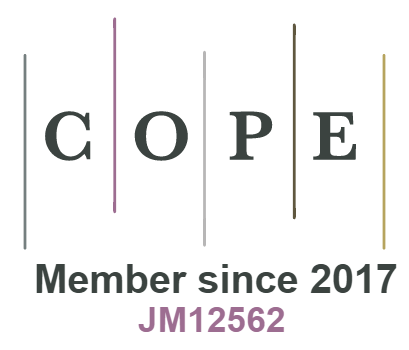Effect of Hematocrit Level on the Blood Flow through Stenosed Artery: A Theoretical Study
DOI:
https://doi.org/10.18034/ei.v3i2.193Keywords:
Hematocrit, Resistance, Skin-friction, Stenosis height, Shape parameterAbstract
In the paper we have focused the effect of Hematocrit on flow parameters, such as resistance, frictional resistance, and skin friction due to stenosis in the artery taking blood as non-Newtonian fluid. It has been found that resistance increases with the increasing of hematocrit level and stenosis height. It is also shown that a skin-friction increase with increasing of stenosis height and decreases with the decreasing of stenosis height. Moreover the effect of stenosis shape parameter is observed on resistance and skin-friction due to different hematocrit level. Finally we compare our result graphically.
Downloads
References
B. Singh, P. Joshi and B. K. Joshi, Blood Flow through an Artery Having Radially Non-Symmetric Mild Stenosis, Applied Mathematical Sciences, Vol. 4(2010), no. 22, 1065 – 1072.
Biswas D. and Chakraborty, U.S., Pulsatile Flow of Blood in a Constricted Artery with Body Acceleration, Appl. Appl. Math., 4(2009), 329-342.
BiswasD.and U. S. Chakraborty. Impact of Hematocrit and Slip Velocity on Pulsatile Blood Flow in a Constricted Tapered Artery, International Journal of Engineering Research and Technology. 3(3), 435-449,(2010)
Blair, G. W. S., and D. C. Spanner An introduction to biorheology, Elsevier scientific publishing company, Amsterdam, Oxford and New York (1974)..
Cho, Y. I. and K. R. Kensey, Effects of the non-Newtonian viscosity of blood on hemodynamics of diseased arterial flows: part 1, steady flows, Biorheology 28(1991). 241-262.
Crowley, T. A. and V. Pizziconi), Isolation of plasma from whole blood using planar microfilters for lab-on-a-chip applications, Lab Chip 5(2005), 922-929.
Eckmann, D., Bowers S., Stecker M., Chenung A., Hematocrit volume expander, temperature and shear rate effects on blood viscosity, Anasth Analg 91(2000), 539-545.
F. J. Walburn, D. J. Schneck, A constitutive equation for whole human blood, Biorheology,13:201(1976).
Forrester J. and D. Young), Flow through a converging diverging tube and its implications in occlusive vascular disease-i, J. Biomech. 3(1970), 297-305.
Halder K., Bull. Math. Biology, 47(1985), 545-550.
Leondes, C. T., Biomechanical systems: techniques and applications, volume IV: biofluid methods in vascular and pulmonary systems: techniques and applications: 4 CRC Press (2000).
Misra, J. C. and G. C. Shit, Blood flow through arteries in a pathological state: A theoretical study, International Journal of Engineering Science, 44(2006), 662-671.
Misra, J.C. and Shit, G.C., , Role of Slip Velocity in Blood Flow through Stenosed Arteries: A Non-Newtonian Model” Journal of Mechanics in Medicine and Biology, 7(2007), 337-353.
Paut O., and B. Bissonnette, Effects of temperature and haematocrit on the relationships between blood flow velocity and blood flow in a vessel of fixed diameter, British Journal of Anaesthesia, 88(2), 277-9(2002).
Pralhad R.N and D.H. Schultz, Modeling of arterial stenosis and its applications to blood diseases, Mathematical Biosciences 190(2004), 203–220.
Shukla J.B., S.P. Gupta and R.S. Rarihar, Biorheological aspects of blood flow through artery with mild stenosis: Effects of peripheral layer, Biorheology, 17(1980); 403-410.
Singh A. K. and D. P. Singh, Blood flow Obeying Casson fluid Equation through an artery with radially non-symmetric mild stenosis, American Journal of Applied Mathematics, 1(1), 11-14(2012).
SomchaiSriyab, Mathematical Analysis of Non-Newtonian Blood Flow in Stenosis Narrow Arteries, Comput Math Methods Med. 2014; 2014: 479152.
Taylor, M.G., “The Influence of Anomalous Viscosity of Blood upon its Oscillatory Flow”, Physics in Medicine and Biology, 3(1959), pp. 273-290.
Ting, T. W. D. and B. S. Wu, Effects of hematocrit levels on the blood hlow in the corrugated vessel due to the implantation of intravascular stents, Biomed. Eng. Appl. Comm, 18(2), 80-86(2006).
Wong, K., J. Tu, J. Mazumdar and D. Abbott, Modelling of blood flow resistance for an atherosclerotic artery with multiple stenosis and poststenotic dilatations, Anziam J. 51 (EMAC2009), C66-C82 (2010),.
Young D. F., Effect of a time – dependent stenosis on flow through a tube, J.Engg. Ind., Trans. Am. Soc. Mech. Engg. 90(1968), 248-254.
--0--
Published
Issue
Section
License
Engineering International is an Open Access journal. Authors who publish with this journal agree to the following terms:
- Authors retain copyright and grant the journal the right of first publication with the work simultaneously licensed under a CC BY-NC 4.0 International License that allows others to share the work with an acknowledgment of the work's authorship and initial publication in this journal.
- Authors are able to enter into separate, additional contractual arrangements for the non-exclusive distribution of the journal's published version of their work (e.g., post it to an institutional repository or publish it in a book), with an acknowledgment of its initial publication in this journal. We require authors to inform us of any instances of re-publication.









